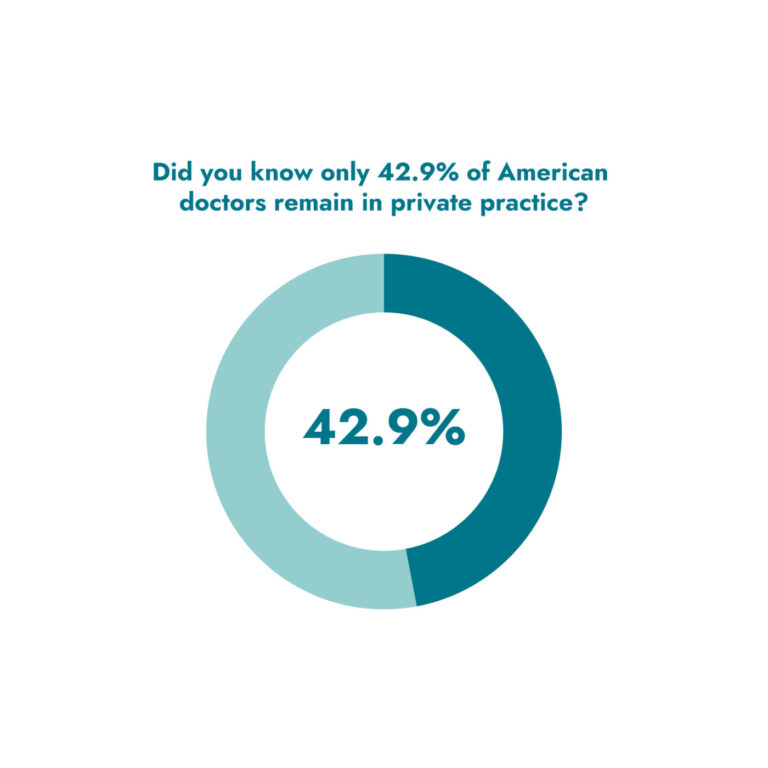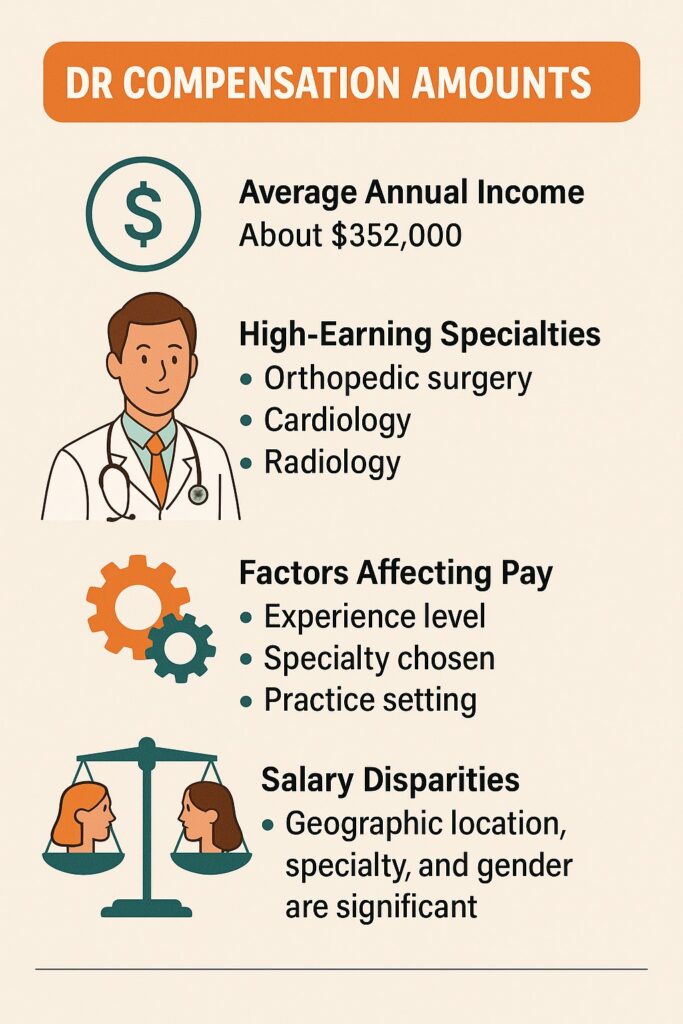What are the Highest Paid Medical Specialties in the US?
Physician compensation in the United States increased by about 3.6% over the past year. While this represents modest growth, it also reflects the ongoing shifts in reimbursement models, specialty demand, and the employment landscape.
This updated guide includes the latest statistics across all key categories — from highest-paid medical specialties and state-level pay variations to the continued income gap between private practice and employed positions, as well as differences in earnings between MDs and DOs. We’ve also added updated context on the wRVU system, Medicare cuts, and the slow transition toward value-based care.
We have compiled a list of medical specialties in the United States with the highest yearly income. The income data is based on several sources, including Medscape, Indeed, and LinkedIn.
Four specialties now average more than $500,000 per year. Here are the top-earning specialties based on the most recent available physician compensation data:
| Specialty | Income |
|---|---|
| Orthopedic Surgery | $543,000 |
| Radiology | $520,000 |
| Plastic Surgery | $516,000 |
| Cardiology | $506,000 |
| Anesthesiology | $499,000 |
| Gastroenterology | $495,000 |
| Urology | $485,000 |
| Otolaryngology (ENT) | $473,000 |
| Hematology/Oncology | $452,000 |
| Dermatology | $424,000 |
| General Surgery | $420,000 |
| Critical Care | $410,000 |
| Pathology | $395,000 |
| Ophthalmology | $394,000 |
| Pulmonology | $387,000 |
| Emergency Medicine | $374,000 |
| OB/GYN | $367,000 |
| Nephrology | $359,000 |
| Physical Medicine & Rehab | $354,000 |
| Psychiatry | $336,000 |
| Neurology | $322,000 |
| Allergy & Immunology | $312,000 |
| Internal Medicine | $286,000 |
| Rheumatology | $277,000 |
| Infectious Disease | $277,000 |
| Endocrinology | $277,000 |
| Family Medicine | $276,000 |
| Pediatrics | $258,000 |
| Preventive Medicine | $257,000 |
Key Trends:
Orthopedic surgeons remain at the top.
Radiology, plastic surgery, and cardiology all cross the $500,000 mark.
Many primary care specialties continue to lag under $300,000.
Dermatology experienced one of the steepest drops in compensation (~11%).
Endocrinology and pathology saw compensation increases near 8%.
How Do Doctors in the United States Get Paid?
Determining and articulating how doctors in the US get paid is almost as difficult as determining how much they earn annually. As we’ve already mentioned, calculating how much a physician earns is dependent on many factors. The healthcare landscape in the United States is constantly changing and evolving due to the introduction of new bills, laws, and other institutional changes.
Let’s review the different factors that affect a doctor’s income.
Private Practice vs. Employed
According to the American Medical Association (AMA), the primary difference in compensation lies in their employment status (employed vs. private practice).
Self-employed physicians continue to outearn employed physicians by about $38,000 annually on average. In 2024:
Self-employed doctors averaged around $391,000.
Employed doctors averaged about $353,000.
The income gap largely reflects profit-sharing and revenue control in private practices. However, only about 47% of physicians are in private practice as of 2025 — a significant decline from over 60% a decade ago. Fewer than 1 in 3 physicians under age 45 now own a practice.
Hospital systems, private equity firms, and corporate entities are acquiring more practices. Many doctors report this change is driven by administrative burdens, challenges with insurance negotiations, and interest in steady income.
wRVUs and Productivity-Based Pay:
Work Relative Value Units (wRVUs) remain the dominant structure for productivity bonuses. While there was a push toward quality-based bonuses, only about 25% of physicians now receive pay tied to patient outcomes — a drop from 64% a few years ago.

Similar to any business owner, self-employed doctors determine their income after accounting for expenses. Patients visit the office, are seen, and the practice bills patients or insurance companies for services rendered. For example, let’s say a doctor’s office in 2023 generated $350k in revenue, with $200k invested in running the business (rent, supplies, salaries). This leaves approximately $150k to be divided among owners.
Please note: This example uses 2023 figures and might not reflect the exact costs and income in 2024 due to potential changes in inflation, patient volumes, and other factors. For the most current information, refer to resources like the Doximity Physician Compensation Report. Additionally, remember that individual income and practice expenses can vary significantly based on specialty, location, and practice size.
It is in the best interest of a private practice to serve as many patients as possible per day. The revenue of the business heavily depends on how many patients they see and bill each day. If the number of patients decreases, so does the revenue.
In recent years, private practices have become less common among physicians in the United States. Per recent data from the AMA, only 47.1% of doctors in America remain in a private practice setting. In contrast, the number of employed physicians is on the rise. Per data from AMA, 55.3% of physicians in the United States were employed in 2020. The percentage of employed doctors has been on the rise for the last decade, with 41.8% of physicians employed in 2012 and 47.4% employed in 2018. Let’s discuss the reasons for this growth in employed physicians and the decrease in self-employed physicians.
As with any business, running a private practice is no easy task. Many doctors grow tired and frustrated with the regulations and responsibilities of managing such an enterprise. On top of dealing with rent and employees, they have to deal with insurance companies and Medicare, and malpractice insurance. For many doctors, being an employee of a hospital or other medical facility provides peace of mind and a stable income. Even though employed doctors are expected to demonstrate a high productivity level, their income is not solely reliant on their productivity.
Although, this is too overly simplistic. Hospitals within the United States have created a protection for reduced physician productivity. Many hospitals throughout the US have created pay packages for their physicians. These pay packages reward physicians who put in hard work. The work relative value unit, commonly referred to as the wRVU, is a system that attempts to reward and compensate doctors for demonstrated enthusiasm and extra work, like seeing additional patients. In this aspect, the revenue model and income of private practices are also present in larger medical institutions—the more patients a doctor serves, the higher they are paid.
Many healthcare systems in the US are looking to change their pay structure to adapt to certain rules put in place by Medicare. However, it is hard to imagine that the US healthcare system would move away from rewarding physicians based on the number of patients they serve. A lot of attention is being paid to both the quality and efficiency, meaning the value of the care will consider more than the number of patients served. As one can imagine, it is hard to find the right balance between the two. With all business models, pay in the healthcare industry is reliant on productivity, but the shift in the structure of healthcare compensation seeks to align productivity and quality of care.

Medicare Cuts and Reimbursement Pressure
Medicare’s 2025 conversion factor is set at $32.35 per RVU, down from $33.29 in 2024 — a 2.83% decrease. This cut, coupled with inflation, is straining compensation structures for both private practice and hospital-employed physicians. Many physicians are reporting decreased morale and reduced bonuses unless their organizations offset these Medicare changes with supplemental pay.
Income Difference by State
The state in which a doctor practices also affects their income. Many would think that states with larger populations would have higher incomes among doctors, but this is not the case. Surprisingly, heavily populated states like California and New York do not even break into the top ten states with the highest paid doctors. This may come down to several factors. Large, economically developed states have an abundance of healthcare options, meaning patients have a lot of options when it comes to choosing a healthcare provider. This would mean that, on average, there are fewer patients per doctor within these states. As previously discussed, the United States healthcare system is structured around earnings based on how many patients one serves. Fewer patients per doctor means less income, which is likely why large, populated states have lower-earning doctors.
States like Alabama, Kentucky, and Tennessee are among the top-earning states for doctors overall. In these states, healthcare options are limited, meaning there are not as many doctors, hospitals, or other medical facilities. This correlates to there being more patients per doctor in these states. In general, physicians who practice in states with lower populations fare better in terms of income than those who practice in large, populated states with an abundance of healthcare options. So a physician practicing in Kentucky would earn more than their counterpart who practices in New York.
Now, let’s go over the ten top-earning states for doctors in the United States.
| State | Average Income/Physician (2025) |
|---|---|
| Wisconsin | $397,000 |
| Indiana | $372,000 |
| Georgia | $363,000 |
| Connecticut | $362,000 |
| Missouri | $361,000 |
| New Jersey | $360,000 |
| South Carolina | $360,000 |
| Florida | $359,000 |
| California | $358,000 |
| Michigan | $356,000 |
Doctors in high-cost states like California and New York are often paid less than counterparts in lower-cost states, largely due to overhead, payer mix, and competition.
Income Difference by Specialty
Primary care practitioners earn an average of $309,000, while specialists earn around $370,000. These are estimated averages based on recent data and may vary significantly depending on factors like individual practice setting, experience, and location. We’ve provided a list of the top-earning medical specialties within the US, which you can reference at the beginning of the article.
Remember, these are estimates, and individual income can vary greatly.
Why does a specialty affect a doctor’s income? To put it simply, some specialties require more skill than others. For example, medical specialties such as cardiology, orthopedics, and plastic surgery are some of the top paid within the United States. All of these specialties are procedure-based and require five to six years of additional residency training after graduating from medical school. The specialties mentioned also tend to demand post-residency, sub-specialty training such as fellowships.
Primary care specialties like family medicine, pediatrics, and internal medicine require less training. Aspiring physicians can become family physicians after six years of education (four years of medical school and two years of residency). While physicians practicing in these specialties earn less, there is an upside. The upside being they have a smaller debt and can enter the workforce quicker by spending less time and money on specialty training. They also accrue less debt because they can begin paying off their school debt quicker.
When it comes to choosing a specialty, you should consider the demand for that specialty within the health field. Often, higher-earning specialties are more in-demand as an increase in earnings often foreshadows a shortage in that field.
MD vs. DO Salary
We cannot avoid mentioning the salary difference between MD vs. DO physicians. DO and MD physicians make comparable income when working within the same specialty; specialty options are more limited for DO physicians. Per the latest data for the Main Residency Data Match, MD and DO graduates are equally competitive for the primary care specialties such as family medicine. However, DOs are less represented within the lucrative surgical specialties. For reference, 23 MD seniors were matched to a dermatology residence program, which is one of the most competitive residencies, but only 6 DO seniors were matched to this same specialty. Another example of this is orthopedic surgery, with 686 MDs matching vs. 112 DOs.
Although there is a discrepancy within the numbers, there has been a large increase in DO representation in competitive surgical residencies. This is primarily due to the changes in the accreditation of residency programs. Osteopathic and allopathic residencies used to be accredited by different institutions: the former by the AOA and the latter by the ACGME. Now, MD and DO programs are accredited by the ACGME, giving osteopathic programs the same status as allopathic programs. The same accreditation allows DOs to participate in MD programs and allows MDs to partake in programs with “Osteopathic Recognition” designation.
The now unified accreditation is closing the gap between MD and DO residents. Over time, the difference in numbers between the two will likely shrink. However, it is important to remember what DO stands for. DOs have a philosophy that leads them to pursue primary care and non-intrusive medical care practices. DOs are capable of becoming surgeons, but their tenets still affect their career choices, such as specialty and where they practice.

For those deciding between becoming an MD physician or a DO physician, it is best to evaluate both programs as a whole rather than based on potential income. Keep in mind when working in the same specialty DOs and MDs earned roughly the same annual income. However, there are many factors to consider when choosing between a DO and MD program. First, one must consider the philosophy of both programs and determine which best aligns with their personal values. You should also consider what medical specialty you’d like to practice. As mentioned, DOs have less representation within surgical specialties, so while this doesn’t mean you can’t be a DO and work within a surgical specialty, it may be easier to get into your preferred specialty as an MD.
MD vs. DO Salary Comparison
The degree alone (MD or DO) does not affect income — but specialty distribution does. On average:
MDs earn about $400,000 annually.
DOs earn around $350,000 annually.
This difference is primarily because MDs are more frequently represented in high-paying surgical and procedural specialties.
Residency Match 2024 Data:
MD match rate: 93–94%
DO match rate: 92.3% (a record high)
However, DOs remain underrepresented in competitive specialties like:
Orthopedic Surgery (13% of residents are DOs; ~48% DO match rate)
Dermatology (7% of residents are DOs)
In contrast, DOs dominate family medicine and primary care, where compensation is lower but entry is more accessible.
Shift Toward Value-Based Care
Although value-based care is a priority for Medicare and some private payers, fee-for-service remains the norm in 2025. Physicians are still mostly compensated based on volume — the number of patients seen or procedures performed.
Models like:
Bundled payments
Shared savings programs
Quality score-based bonuses
…are in use, but not yet widespread enough to dominate physician compensation. For most doctors, productivity (measured in wRVUs) remains the primary determinant of pay.
Summary: Physician Compensation in 2025
Orthopedics, radiology, and surgical specialties remain the top earners.
Primary care, pediatrics, and public health are among the lowest earners.
Self-employed doctors outearn employed peers, but the number of private practices continues to decline.
Geographic location significantly impacts income, with Midwestern and Southeastern states typically leading.
MD vs. DO pay is comparable in the same specialty, but fewer DOs enter the highest-paid specialties.
wRVU-based productivity pay is still king, while value-based care adoption remains sluggish.
Physicians should continue to monitor reimbursement trends, Medicare changes, and specialty-specific opportunities to ensure fair and sustainable compensation. For aspiring physicians or residents evaluating specialty choice, salary should be one consideration — balanced with training length, competitiveness, work-life balance, and personal values.
If you’re unsure which specialty best fits your goals, residency admissions consulting and international internships (like those offered through IMA) can provide meaningful exposure and decision-making insight.
Economic Impact of Medical Specialties on Healthcare Systems
In analyzing the economics of healthcare systems, the financial trajectories of medical specialties are not isolated figures. They reflect broader economic currents within the medical industry. High-earning specialties often indicate areas where patient demand intersects with complex, resource-intensive procedures. For instance, specialties like orthopedics and cardiology involve advanced surgical procedures and ongoing care, which typically incur higher costs and, consequently, higher revenue streams for healthcare facilities.
The financial health of hospitals and clinics is inextricably linked to the services provided by these high-earning specialties. These departments can be significant profit centers, helping to subsidize other vital but less lucrative areas of care. For example, a hospital’s state-of-the-art cardiology wing can fund community health initiatives or undercompensated care that benefits the broader population.
Concentration of High-Earning Specialties
Furthermore, the concentration of high-earning specialties has implications for healthcare accessibility. Regions with a higher density of well-compensated specialties may attract more medical talent, which can improve local healthcare services’ quality and availability. Areas predominantly served by lower-earning primary care providers may struggle with attracting and retaining physicians, impacting patient access to specialized care.
The cost of care is another aspect influenced by the distribution of medical specialties. High-earning specialties often require significant investment in technology, facilities, and staff training. While they bring in substantial revenue, they also contribute to the rising costs of healthcare for patients and insurance providers. This raises questions about the sustainability of current healthcare models and the potential need for reform, particularly in how medical services are valued and reimbursed.
The remuneration associated with various medical specialties is not merely a reflection of individual doctors’ income potential. It embodies complex dynamics within healthcare economics, affecting everything from hospital operations and healthcare accessibility to the overall cost of medical services. A nuanced understanding of these dynamics is crucial for stakeholders at all levels, from policymakers and healthcare administrators to medical professionals shaping their career paths.
Shift Toward Value-Based Care
The healthcare industry is undergoing a transformative shift from a volume-based to a value-based care model. This paradigm shift is poised to reshape not only healthcare delivery but also the financial incentives that underpin the medical profession. The volume-based system, which rewards the quantity of services provided, is giving way to a model that prioritizes the quality of patient outcomes and the efficiency with which care is delivered.
This movement towards value-based care is driven by the need to curtail rising healthcare costs while improving the standard of care. In the value-based framework, physicians and hospitals are compensated for helping keep people healthy and for improving the health of those with chronic conditions in cost-effective ways. This model can potentially de-incentivize unnecessary procedures and tests, which can sometimes be a byproduct of the fee-for-service models where healthcare providers are paid for each treatment, scan, or test.
For high-earning specialties, the implications are multifaceted. On the one hand, specialties known for high-intervention procedures, such as orthopedics and cardiology, may see a shift in their income structure. Where previously the income was directly proportional to the number of procedures performed, value-based models may require these specialists to demonstrate that such procedures are not just medically necessary, but also cost-effective and beneficial in terms of patient outcomes.
Value-based Care Model and Comprehensive Care Coordination
Moreover, the value-based care model emphasizes comprehensive care coordination, which can impact how specialists collaborate with primary care physicians and other healthcare providers. In this context, high-earning specialists will likely need to establish more integrated relationships with other practitioners, ensuring that patient care is optimized across the continuum, from prevention to intervention and chronic disease management.
However, the shift to value-based care also presents opportunities for specialists. Those who can adapt by focusing on patient outcomes and cost-effectiveness may find themselves at the forefront of an industry trend. For instance, orthopedic surgeons who adopt less invasive, patient-centered approaches that demonstrate faster recovery times and lower complication rates may be well-positioned in a value-based landscape. Similarly, cardiologists who integrate lifestyle intervention and medical management to reduce hospital readmissions for heart failure could be seen as models for value-based care.
The transition also has implications for how high-earning specialists negotiate contracts with payers. As value-based metrics become more prominent, these specialists will need to understand and engage with new performance indicators and reimbursement models. This includes bundled payments, where providers receive a single payment for all the services needed to treat a particular condition or care episode, and shared savings programs, where providers are rewarded for reducing healthcare costs while meeting quality benchmarks.
Adapting to value-based care requires not only clinical and operational changes but also a cultural shift within practices and healthcare systems. High-earning specialists must embrace a patient-centric approach that values long-term outcomes over immediate volume. This involves investing in health IT systems for better data tracking and patient engagement, rethinking care pathways to focus on prevention and patient education, and adopting a more collaborative mindset.
The shift towards value-based care is a clear signal that healthcare is evolving, and with it, the financial models that have traditionally defined physician income. For high-earning specialists, the change is both a challenge and an opportunity to redefine their roles within a system increasingly focused on value over volume.
The Role of Medical Education in Specialty Choice
The trajectory of a medical career and the eventual specialty choice a physician makes are heavily influenced by the medical education they receive. The journey to becoming a high-earning medical specialist starts in the lecture halls and clinical rotations of medical schools, where future physicians’ aspirations take shape.
Medical schools play a pivotal role in specialty selection. The exposure students receive to various specialties can significantly sway their career choices. Schools that offer extensive rotations and electives in high-earning specialties like orthopedics or cardiology provide students with insights into these fields, potentially increasing their interest in pursuing them. Conversely, if a medical school emphasizes primary care in its curriculum, students may be more inclined to consider specialties like family medicine or pediatrics.
Educational debt is another crucial factor influencing specialty choice. With the cost of medical education soaring, the debt burden upon graduation can be overwhelming. For many students, this financial pressure nudges them toward higher-paying specialties to manage and eventually pay off their debts. This economic reality can skew the distribution of specialists, with more new doctors gravitating towards lucrative fields and away from less remunerative, yet equally essential, primary care roles.
The imbalance created by this migration towards high-paying specialties is not without consequences. It can lead to a shortage of primary care physicians, which is already a pressing issue in many parts of the United States. This shortage can compromise the accessibility and quality of healthcare, particularly in rural and underserved urban areas where primary care services are most needed.
Conclusion
Choosing a specialty, state to practice in, and employment status solely based on how much money you may earn is not wise. Money alone can not sustain one’s passion and dedication for their chosen career. In many ways, your personality and experiences will determine both your specialty and employment status. Some enjoy the autonomy of owning a private practice, while others prefer the steady income and stability offered by being employed at a medical facility.
Although it is difficult to make calculations about what the highest paid medical specialties or highest paid doctors are, there is no doubt that some physicians and specialties are among the top earning in the United States. When considering a doctor’s income, it is crucial to consider how long it takes to become a doctor. Earning a medical degree is a huge investment of one’s time, money, efforts, and mental health. The majority of physicians continue paying off their medical school debts long after they have graduated and begun their careers.
In addition to the debt one takes on, the vocation of a physician is not for the faint of heart. The career involves duties and responsibilities many cannot fathom. While there are a considerable amount of challenges associated with becoming a physician, one of the latest surveys done by Medscape shows that 77% of polled physicians would choose a career in medicine again if they were still deciding on their future career path.
For those of you who feel you may need additional guidance when it comes to choosing a medical specialty, we recommend seeking the assistance of residency admissions consulting. In addition to admissions consulting, taking part in a medical internship abroad may also aid in making a career path decision. The healthcare internships offered by IMA are a great opportunity to explore new, exciting areas and cultures while gaining hands-on experience in a variety of medical specialties, from cardiology and general surgery to pediatrics and internal medicine.
Frequently Asked Questions
What are the highest paid doctors in the United States?
As of 2025, orthopedic surgeons remain among the highest-paid medical professionals in the United States. Recent data indicates that the average annual salary for orthopedic surgeons is approximately $723,421, reflecting a 5.5% increase from the previous year. This compensation places them at the top of the physician salary spectrum.
It’s important to note that physician salaries can vary significantly based on factors such as geographic location, years of experience, subspecialty, and practice setting. For instance, orthopedic surgeons practicing in the Southern and Midwestern regions of the U.S. tend to earn higher median salaries, with figures reaching up to $702,480. Additionally, those specializing in areas like spine surgery or hand surgery may command even higher compensation due to the complexity and demand of these subspecialties.
Overall, while orthopedic surgery is a lucrative field, individual earnings are influenced by a combination of personal and professional factors.
What affects a doctor’s income in the US?
The primary factor that affects a doctor’s income in the United States is their employment status. Whether they are self-employed/ own a private practice or are employed by a hospital or other medical facility, other factors, such as the doctor’s specialty, affect their income. On average, surgical specialties are among the highest paid doctors in the US, while primary care is among the lowest paid. The state in which a physician practices also affects their income; reference our previously listed ten top-earning states for physicians above.
How do doctors in the United States get paid?
When it comes to getting paid as a doctor in the US, your pay primarily depends on your employment status. If you choose to become a self-employed doctor and run a private practice, your income will be heavily dependent on how many patients you serve. While the productivity of employed physicians is a factor in their salaries as well, it is not as large a factor as it is for self-employed doctors. Doctors employed by hospitals and medical centers have a more stable, steady income.
Why do doctors in the primary care field get paid less?
Although primary care physicians typically see and serve more patients than other specialized physicians, they typically charge less for their services. This reduced charge stems from the primary care field requiring less training and education than other specialties. In the United States, becoming a family medicine physician requires around six to seven years of education (four years of medical school and two years of residency), while it takes nine to ten years to become a doctor in a surgical specialty. Surgical specialties require extra skill, and therefore, the services of these physicians end up costing more than those of a primary care doctor.
Are there any advantages monetarily to becoming a primary care physician vs. a specialist?
Yes, it is true that specialists earn more. They also tend to accrue higher amounts of debt, spending both more time and money on their education. We are not here to dissuade anyone from becoming a specialist. However, money should not be the sole reason you choose to go into a medical specialty. Primary care physicians earn less but have less medical school debt due to graduating sooner and getting out into the workforce quicker. Those within the primary care field, such as family medicine physicians, spend roughly six years receiving their education as opposed to specialists who often spend ten years receiving theirs. Less time spent in medical school equates to less debt and being able to earn money sooner. Simply put, many of the highest paid doctors also have a high amount of medical school debt.
If you feel you may need additional guidance on choosing the best medical specialty for you, consider seeking the professional help of residency admissions consulting or partaking in one of IMA’s pre-med shadowing study abroad programs.
Is there an income difference between MD and DO physicians?
Yes, there is an average income difference between DOs and MDs in the United States, but this difference is largely a reflection of specialty distribution rather than degree-based pay discrimination.
As of the most recent 2024 earnings data, MDs reported an average annual income of approximately $400,000, while DOs averaged closer to $350,000. This ~14% gap can appear significant at first glance, but it’s important to understand what’s behind the numbers.
DOs are statistically more likely to enter primary care specialties, such as family medicine, internal medicine, and pediatrics — fields that tend to have lower compensation. In contrast, MDs are more commonly represented in surgical and high-paying procedural specialties like orthopedics, cardiology, and radiology. These specialties not only require longer post-medical school training but also carry higher reimbursement rates.
When DOs and MDs work within the same specialty, studies consistently show that their salaries are virtually identical. Employers do not typically differentiate pay based on the physician’s degree type — compensation is based on the role, responsibilities, and clinical performance.
In summary, the income difference between DOs and MDs is not about one being paid less for the same work, but about the proportion of each group practicing in higher- or lower-paying fields. As more DOs enter competitive specialties — a trend that has been growing since the merger of MD and DO residency accreditation — this income gap is expected to narrow further.





